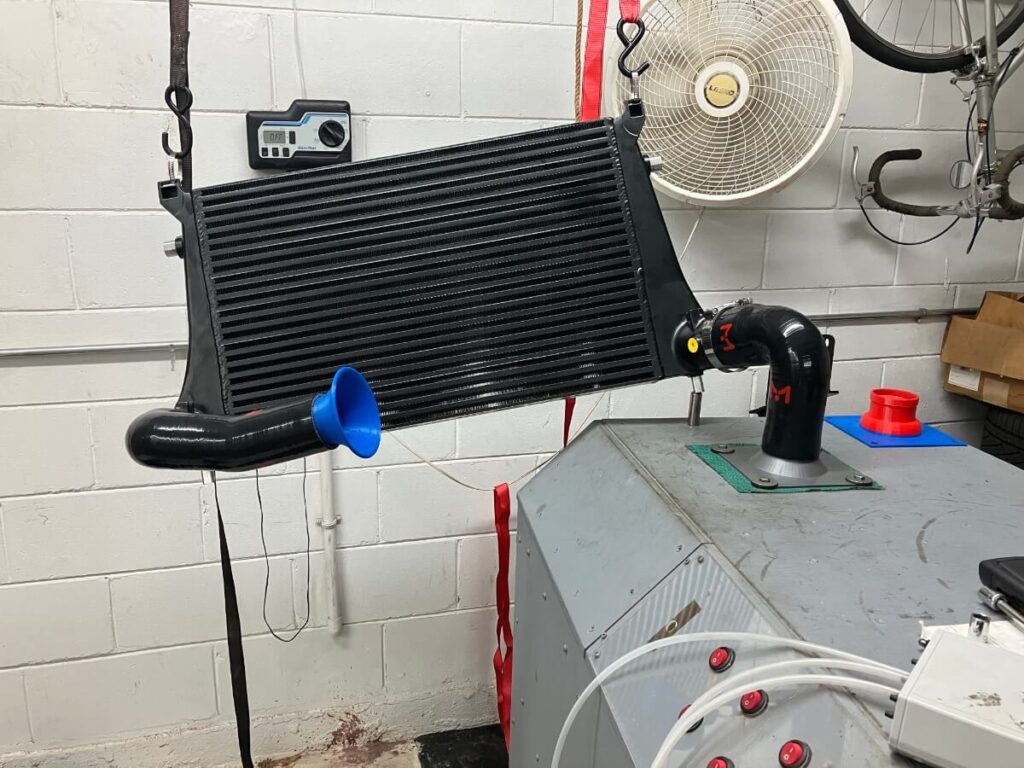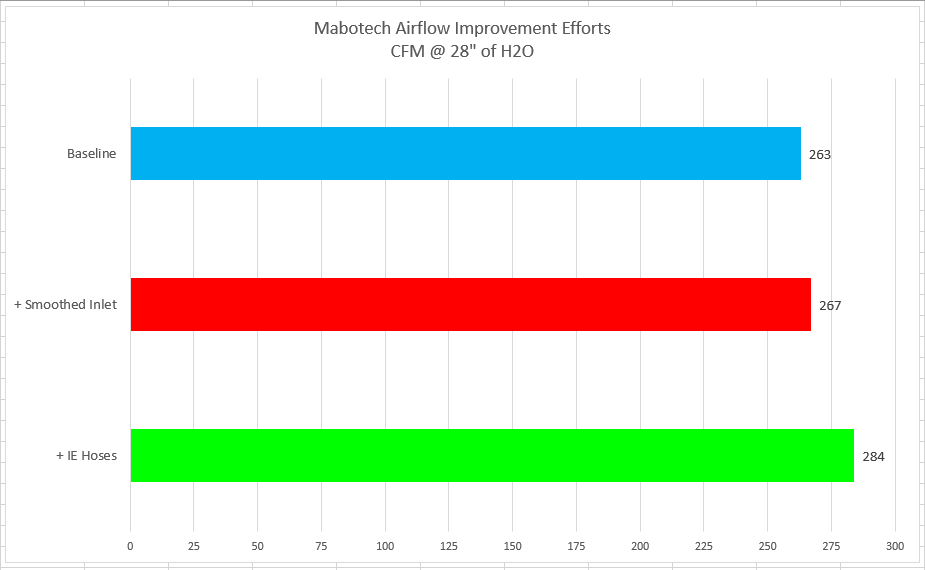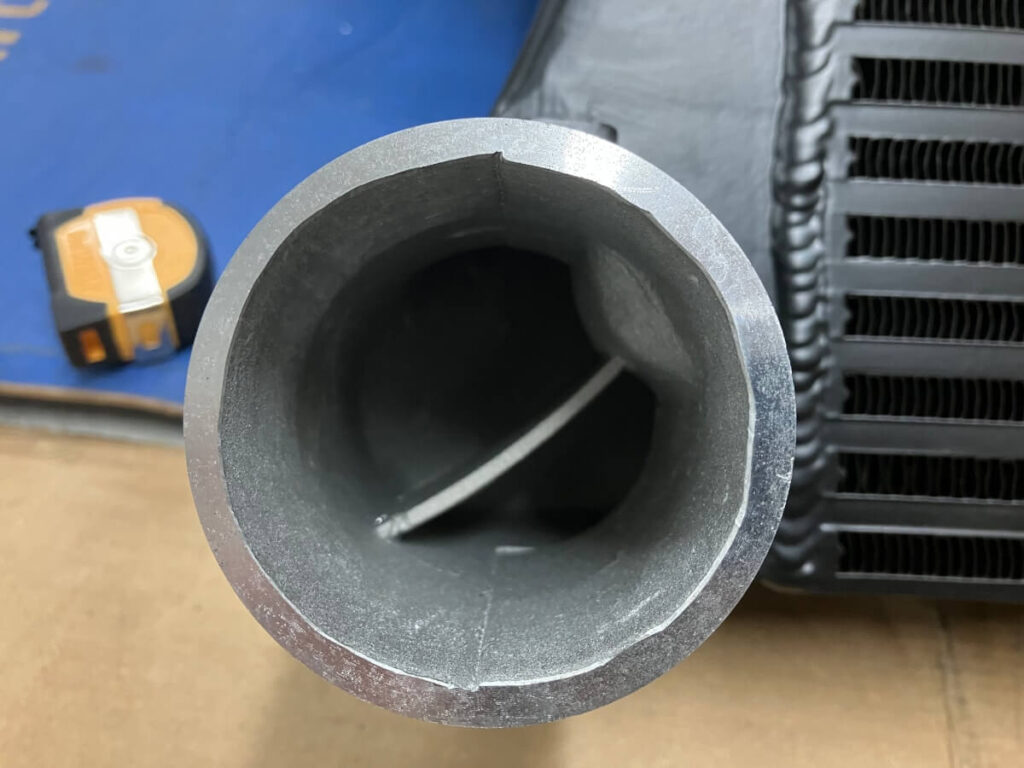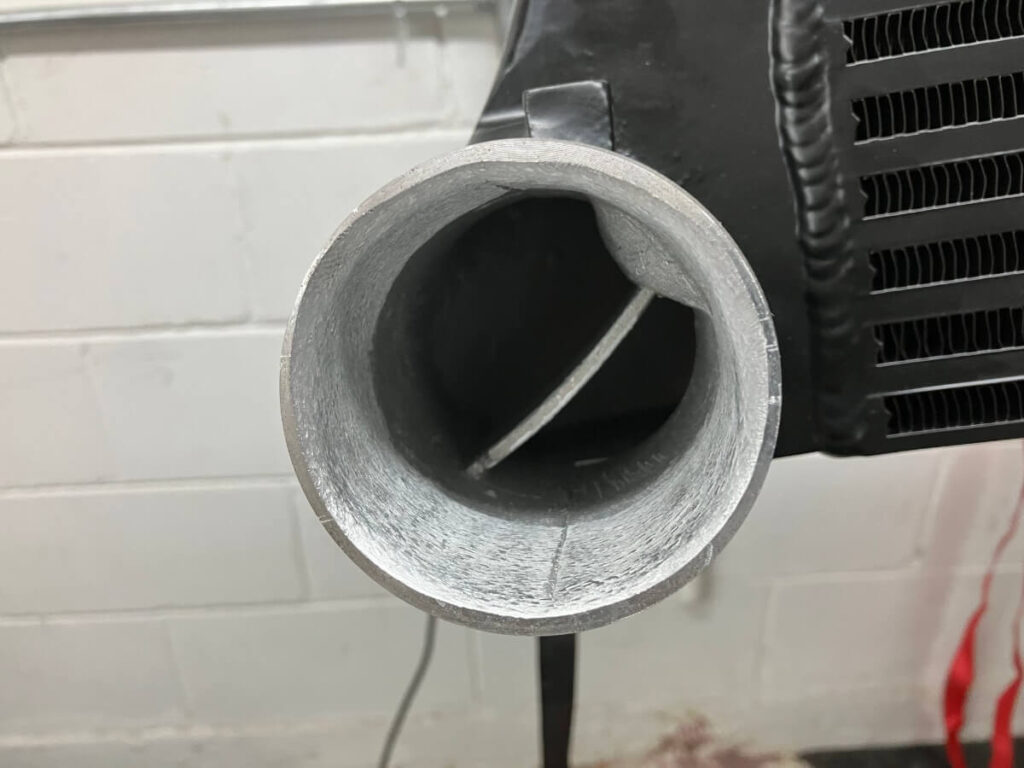Background:
In a previous post, I gave a rundown of the dimensions of the Mabotech Mk7 “Race” intercooler. The Mabotech intercooler is a stock location replacement intercooler for the Mk7 GTI and Golf R.

This post will address a flow bench test that was conducted using the Mabotech IC.
Airflow and pressure drop:
Flow testing is done using a PTS Flow Bench to evaluate the pressure drop across the exterior fins and internal fins of the intercooler.
Exterior flow “may” give some idea of how well the intercooler supports the cooling of the radiator.
Interior flow factors into how much pressure the turbocharger must create to meet the demands of the engine computer. A lower flowing intercooler correlates with a greater pressure drop, and a greater pressure drop increases the work the turbocharger must do to meet the engine’s needs.
Note: I have not mapped pressure drop with engine power output. This means that whether an intercooler flows a lot or a little, I don’t know how much engine power output is affected. In principle, more airflow is better.
Test Procedure:
The flow bench is first operated with a calibration plate to check that the bench and digital manometer are functioning properly.
External airflow is measured by placing the intercooler core onto an adapter that draws air into the flowbench through the IC external fins.
The bench is operated at a depression of 10″ of H2O and the airflow reading is recorded.
The intercooler is rotated twice, taking measurements with each rotation, to produce enough data to calculate an average flow rate.

The intercooler is next suspended and the inlet and outlet hoses are attached to the end tanks. A bellmouth is placed inside the inlet hose and the outlet hose is attached to an adapter that is fixed to the flow bench.

The bench is operated at a depression of 28″ of H2O and the airflow reading at that pressure is recorded.
Test Results:
The external airflow test yielded an airflow rate average of 421 CFM @ 10″ of H2O.
This is shown on the chart along with other intercoolers that have been tested for this property.

The internal airflow rate through the “as delivered” intercooler is 263 CFM @ 28″ of H2O.
Emphasis is made on “as delivered” since a couple of modifications were made to check the effect on airflow.
When I was first examining the intercooler I noted that the inlet pipe had a sharp inner edge (Left image below). By rounding the edge slightly I thought the airflow rate might increase through the system. I used a hand file to round the edge and smoothed it with a Dremel tool (Right image below).
The resulting change to the airflow rate was disappointing even though there was a positive effect. Airflow increased from 263 CFM to 267 CFM.
Note: The change was made in two steps. The first took the sharp edge off the inlet which produced the 4 CFM increase. Thinking, well if some smoothing is good more must be better, I continued to round and smooth the edge some more. The second effort produced 0 CFM of gains, or staying positive, the gains might have been there but were less than I could measure.
Something else I noticed was that the Mabotech silicone hoses have relatively sharp bends on the inside radius. The IE v1 intercooler has the same size inlet/outlet and a smoother bend. (See picture below.)

The next experiment was to substitute the IE v1 hoses for the Mabotech hoses.

This change also had a positive effect on the airflow, increasing from 267 CFM to 284 CFM.
Note: Mabotech has revised the IC silicone hoses since this post was originally made to smooth the bends.
The results of the experiments are shown on this chart:

The best case test result is shown on the next chart with other stock location intercoolers.

Conclusions:
The Mabotech “Race” intercooler for the Mk7 was tested for external and internal airflow rates.
The external airflow rate is 421 CFM @ 10″ of H2O. This is the second-highest airflow rate measured for all the intercoolers that have been tested. This is the highest airflow rate measured for an aftermarket intercooler, of the ICs that have been tested.
As delivered the internal flow rate through the Mabotech intercooler was 263 CFM @ 28″ of H2O. This is the second highest reading of the stock location intercoolers that have been tested.
Smoothing the inlet of the Mabotech end tank increased airflow to 267 CFM @ 28″ of H2O. This rate equals the highest flowing aftermarket intercooler that has been tested, the do88 IC.
Using the Integrated Engineering v1 intercooler hoses in place of the Mabotech hoses resulted in an airflow reading of 284 CFM @ 28″ of H2O. This is the highest airflow rate measured from any intercooler, or combination in the case of bicoolers, that have been flow tested. This flow rate is approximately 6% greater than the flow rate of the second place do88 intercooler.
Note: I tried the do88 silicone hoses as well. They don’t fit onto the Mabotech as well as the IE hoses do, but they resulted in similar airflow gains.

As was observed previously with the Integrated Engineering v2 intercooler, the added core depth apparently helps to increase airflow through the core. This is logical since a larger passageway should create fewer restrictions (lower velocity leading to less friction losses). A common depth for aftermarket IC cores is 2.25″. At 2.75″ the Mabotech core has 22% more area for air to flow through, ignoring any other internal design differences.
The Mabotech IC has larger inlet/outlet piping, and this may account for some of the gains it shows over the similarly sized IE V2 intercooler.
Of course, there is a lot to the internal design of these intercoolers that cannot be seen, and the internal design may be factoring heavily on these flow results.



Any plans on testing the cooling efficiency of the Mabotech race cooler ??
I do plan to install it and see how it compares with the other ICs I’ve used. It will probably be a few weeks before I can get to it.
Hello Jeff how you manage to fit the IE hose on the Mabotech intercooler ?
I have the first version of the IE intercooler, it had larger piping on the end tanks so these hoses are the right size to attach to the Mabotech IC.